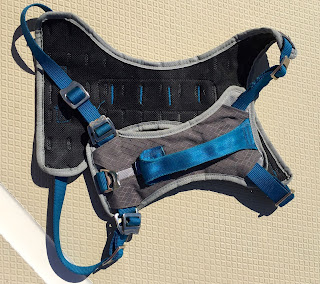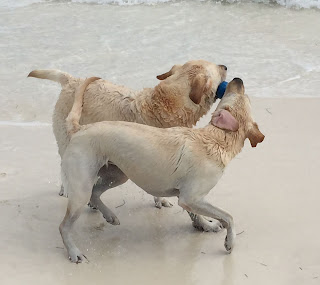 |
| The crew underway. |
In our quest to learn from our experience and provide better safety onboard for our crew, we have spent the intervening months testing a variety of dog harnesses. First, I want to state that any of the harnesses that we tested served the function of lifting the dogs and were better options than the Kong harness which failed us with Dee Dee.
Second, there is no such thing as a perfect harness that will work with every dog. Like people, dogs come in all sorts of shapes and sizes. There are many factors involved that are personal to your canine crew member, water skills, for example. Fortunately, there are lots of harnesses on the market so you are sure to find something that will work for you.
As I've stated previously, the safest option in all cases is a quality canine life jacket and both Kurgo and RuffWear offer these. For us, we wanted a more comfortable option for our crew which are excellent swimmers and spend extended time underway including occasional overnight passages.
What I hope to provide here is a framework you can use to seek out the solution that is best for you and your precious crew. Following are the components you should look for in a safety harness.
Key Harness Components
1. Belly Plate
The belly plate gives you a firm foundation for lifting the dog making it easier. It distributes the dog's weight so you're not putting too much pressure in any one place. Lifting even a small dog from the water back into a boat creates quite a force on his body. I believe a good belly plate makes lifting not only easier but safer as well.
2. Safety Loop
The safety loop is an important feature for several reasons and it really does live up to its name. Bringing a dog back to the boat from the water is not the same as grabbing the harness while walking. The safety loop lets you use a boat hook to catch the dog and bring it up to the boat. It then gives you a good target to grasp and lift the dog. It also offers you an easy way to control the dog when needed.
Having the loop positioned between the shoulders will make lifting easier. A dog trying to get back into a boat will typically try to climb in with his front paws. This was what Dee Dee did when she returned to the boat. Having the handle placed between the shoulders allows you to work with that motion to bring the dog in.
3. Secure, Comfortable Fit
Consider all factors about your dog and not just weight and girth. Factor in the dog's length and where that girth strap will fall. Is your dog deep chested, like ours, or more barrel shaped? Find out the length of the belly plate to determine where it will rest on your dog's torso. You want something that fits snugly with minimal shifting, yet is comfortable during long term use. Good padding, especially at pressure points, is also important.
 |
| Dee Dee's medium size harness on the left. Dylan's large on the right. |
Make sure you can return the harness if you do not like the fit. And if you are unsure order multiple sizes. It is important to take care in finding the proper size and then fitting it to your dog. Remember, he will most likely be wearing the harness for many hours.
Following are the conclusions we came to for the harnesses that we tested. Remember, this is based on our very special crew members, so the specific harness we selected may not be the one for your precious bundle. My hope is that you will find the process we went through helpful.
 |
| Web Master Harness |
The Web Master Harness
This well made harness has two lifting straps that did work for both Dylan and Dee Dee. However, their placement near the rear legs made the lifting more difficult. This may well be less of an issue with a smaller dog. Dylan and Dee Dee weigh 64 and 54 pounds respectively, so I definitely needed some help lifting them. The belly straps are well padded but the harness lacks a belly plate which better distributes the dog's weight when lifting. While this harness worked fine, I think there are better options.
 |
| Front Range Harness |
The Front Range Harness
I really like this harness. It fit Dee Dee perfectly and has a good belly plate. The black plastic clips are easy to work with and do not rust. If this harness had the traffic loop, it would be a definite winner. I had numerous communications with RuffWear hoping they would consider making this adjustment. Their final response was:
"...there are no plans to add a handle to it in the future. We believe that the harness itself functions as a handle and therefore, that need is being met for most users. I understand that for pulling a dog out of the water, this is not ideal. Unfortunately, we are not able to meet every need within a single product."
I hope they'll change their mind in the future or have a way to add a loop.
 |
| Pinnacle Harness |
I like this harness a lot as well. It is my favorite of the ones we tested. It has a very large belly plate, the least amount of webbing to stretch, and a large safety loop that sticks up nicely on Dylan's back. If we had been able to fit this harness to Dee Dee it would have been my single choice.
 |
| Tru-fit Harness |
The Tru-fit Harness
This is also a good harness with its only drawback being webbing on the back rather than a back plate. However, this did not seem to impact the ability to lift. This harness has the added benefit of being a crash-tested car harness. And it has the maximum adjustability of all the harnesses we tested. This turned out to be the best option for Dee Dee.
 |
| Dylan and Dee Dee test the Tru-fit harness in the car. |
I have been communicating with Kurgo about the corrosion issue and they are looking into offering an option with stainless steel buckles. I for one would be happy to pay more for a longer lasting product. Of course, they need to determine what the added cost would be and if the market is big enough to make the design change.
 |
| Tru-Fit Smart Harness with Plastic Quick Release Buckles |
As the crew was working on this series, we discovered a version of the Tru-fit harness that has plastic clips for the girth strap. As this is the most manipulated strap, this should certainly help the rusting issue. I have obtained one for testing (sorry, Dylan and Dee Dee, you're just gonna have to do some more swimming...). Note, this harness is not a crash-tested restraint. The crew will let you know what we find in a future posting.
The crew on aCappella hopes that you never need to use your dog's safety harness in a real situation. But as our littlest crew member taught us, the need can happen in an instant. Make sure that you are prepared. Get a good safety harness, practice using it, and then get out there and go cruising
































